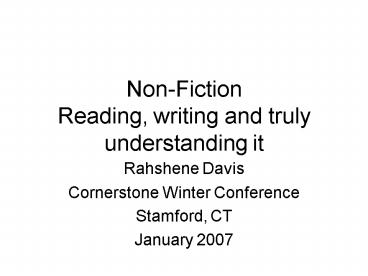NonFiction Reading, writing and truly understanding it PowerPoint PPT Presentation
1 / 22
Title: NonFiction Reading, writing and truly understanding it
1
Non-FictionReading, writing and truly
understanding it
- Rahshene Davis
- Cornerstone Winter Conference
- Stamford, CT
- January 2007
2
(No Transcript)
3
Mode VS. Genre
4
Nonfiction Genre
- Most likely to spur childrens passion and wonder
for learning. - The genre that best lets us explore and
understand the real world. - Allows us to investigate the real world and
inspires us to dig deeper to inquire and better
understand.
5
As teachers we can
- Share our own passion and wonder about the real
world. Passion and wonder and contagious. - Surround kids with compelling nonfiction of every
type and form. - Match the reading to the writing.
- Emphasize short text for nonfiction reading and
writing instruction and practice. - Engage in the inquiry process ourselves-modeling
instruction, showing our thinking, demonstrating
how we do things, and giving our students time to
practice. - Build in long blocks of time for students to
explore their thoughts and questions, to read
text of their choice, to research topics of
interest, and to practice reading and writing
strategies.
6
Outside of school about 80-90 of the reading
adults do is nonfiction
- Newspapers
- Magazines
- Memos
- Manuals
- Directions
- Informational Trade Books
-
(Zinsser,1998)
7
We need to get more trade nonfiction into our
classes
- So children can
- Read it
- Appreciate it
- Learn from it
- Write it more authentically
8
Its not enough to simply provide access!
- We need to
- Read nonfiction aloud
- Explore nonfiction to satisfy curiosity
- Use nonfiction for instruction
- Read nonfiction to find out information
- Read nonfiction to do research
- Skim nonfiction to answer questions
- Show particular features of nonfiction - titles,
headings, bold print, graphs, charts, - and point
out the purpose of these text elements - Read nonfiction to write it well
-
(Maxim,1998)
9
What we know about Nonfiction
- Feature
- Bold print
- Caption
- Table of contents
- Heading
- Subheading
- Distribution map
- Purpose
- Make you stop and pay attention
- Describe the photograph
- Divide the book into sections / chapters
- Tell you what the following text is about
- Break the text up into smaller parts
- Show where something occurs
10
Three Criteria for Book Choice
- Content - books that relate to the curriculum or
topic of study, that you are passionate about, or
that we suspect will capture our childrens
imagination. - Text Features - books that present text features
such as maps, graph, charts, headings, which
support readers as they read the information. - Writing Quality - books that are written in a
compelling, visual way that engages readers and
offers strong models for writing.
11
Children are naturally curious, with a great
thirst to know about the world around them. They
are not bored by facts, data or information they
are only bored by how such information is
presented or what they are expected to do with
it. (Doiron,1994)
12
Match the Reading to the Writing
- Unless we are training our students for a career
in encyclopedia writing, we need to search for
better models of authentic nonfiction. - Teach our students that their best writing
teachers are the authors they love, not the
encyclopedias they need for beginning research.
13
Emphasize Short Text
- Short text is
- well crafted with vivid language and striking
illustrations and photographs. - self contained and provides a complete set of
thoughts, ideas, and information. - Focused on issues of critical importance to
readers of varying ages. - easily read aloud giving a common experience to
everyone in the room. - easily reread for deeper meaning
- accessible to all kind of readers the length is
less likely to intimidate. - a realistic model for writing.
- authentic and prepares kids for real world
reading (Harvey Goudvis, 2000)
14
Choosing Short text
- For the following reasons
- Content - search for pieces that will engage our
children, support and build background knowledge
of the content we are teaching. - Strategy Practice - search for pieces that push
our thinking, demand that we question, visualize,
infer, or synthesize to acquire information and
understand. - Features - that signify importance, such as
heading, bold prints, italics, captions, so that
we can show authentic examples, discover their
purpose, and better understand the genre. - Format - such as newspapers, magazines, and
picture books and notice how they compare. - Form - including essays, letters,, feature
articles, columns, to expose students to
different characteristics of each form. - Text Structure - clip different short text forms
to examine different cue words and text
structures. ex. But, expect a chang., - Writing Quality - delicious writing, our best
writing teachers author the nonfiction texts we
read. - Perspective - articles that might spark
differences in opinion to enhance classroom
discussion. - Surprising Information - unexpected information,
a headline that read Misunderstood Sharks, Not
feeding Machines, Kids love surprising
information (Harvey Goudvis 2000).
15
Recount
16
Non-Chronological Report
17
Instructions Procedures
18
Explanation
19
Persuasion
20
Discussion
21
Creating a Culture of Thinking in our Classrooms
- Thinking, understanding and engagement flourish
in classrooms that foster real-world inquiry. - When we build in time to share our passion and
encourage sincere questions surround our children
with compelling nonfiction, match the reading to
the writing, model how we learn and give students
long blocks of time to delve into and practice
with text of their choice, children come alive
and learning explodes.
22
Nonfiction is the genre most likely to spur
enthusiasm
- The real world has something for everyone.
Life is nonfiction. - (Beverly Korbin 1990)

